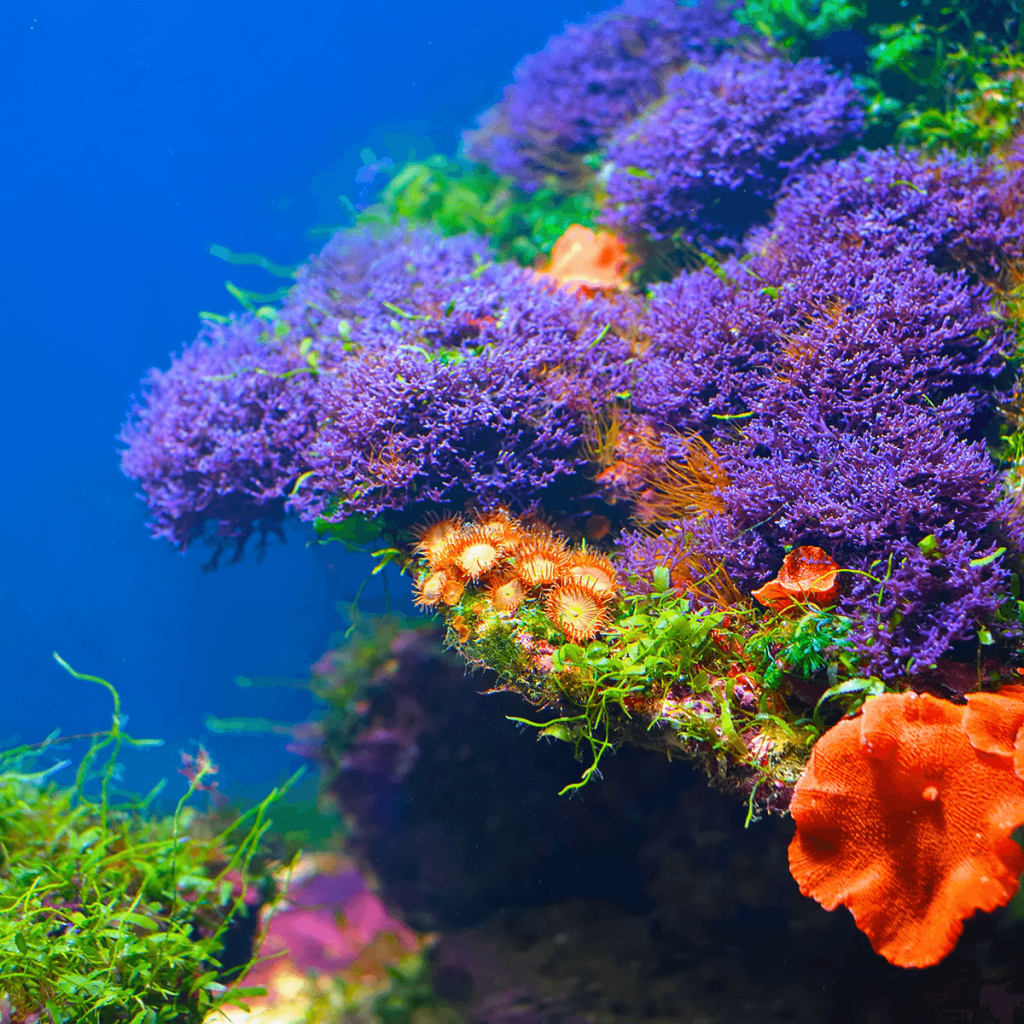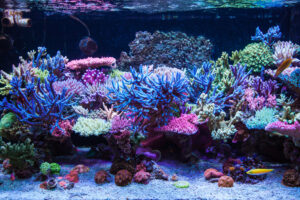The cultivation of saltwater plants is nothing new. It has been fairly common for hobbyists to keep marine “plants” (more often macroalgae than true vascular plants) since the 1980s. Even so, we’ve seen very few aquarium systems that are built and maintained primarily for the display of marine flora. Indeed, to date, the vast majority of marine aquarium plants have been restricted to the refugium where any ornamental purpose is a “bonus” or afterthought.
A (Very Short) History of Planted Aquariums / Marine Gardening
For sure, the popularity of macroalgae that we are now seeing is a bit of a comeback. The original, undisputed heavyweights of aquarium seaweeds were various species of the genus Caulerpa. These fast-growing green macroalgae were once considered to be quite valuable both for their capacity for nutrient export and for their exotic, plant-like appearance. But then, introductions into and subsequent invasions of nonnative habitats gave the entire group a bad rap (ill repute that one could argue belongs only to a few careless handlers). Then, due to the handful of reports of certain caulerpoid species “going sexual” and fouling aquarium water (when stressed in poor conditions), the use of Caulerpa of all kinds declined sharply. Because Caulerpa was THE type of macro to use for refugia, the use of refugia declined universally.
By the end of the first decade of this century, we saw advancements in lighting technology (particularly improvements in LEDs) that soon led to the development of the algal reactor. The basic algae reactor design made the most efficient use of early LEDs, which were generally less intense than those produced today. These water filtration devices predominantly utilized the green alga Chaetomorpha. The rigid, wiry structure of “chaeto” does indeed make it well-suited for the reactor as it resists packing under the strong, unidirectional flow.
[macroalgae]
Nevertheless, aquarists soon found that chaeto grows equally well in the refugium. A few other, fleshier macros quietly entered the scene. These were equally effective for nutrient sequestration but did not work so well in reactors (Ulva, for one example).
By around, say, 2015, refugia gradually began to displace reactors. There were several reasons for this. Being open, they are considerably more accessible and hence easier to service or to harvest plant material. They are less complicated to build and are therefore more appealing to the many DIY hobbyists. Lastly, the increased output of the average LED aquarium light fixture (some with plant-specific spectra) all but erased the advantages that made algae reactors so appealing in the first place.
Certainly, algae reactors are a piece of genius and work extremely well for a specific purpose (i.e. nutrient export) in certain applications (e.g. tight spaces). But in essence, refugia are tanks. As such, they are better equipped to show off the natural beauty of a healthy bed of seaweed.
Displaying (yes, truly displaying) the vegetative side of one’s captive ecosystem has not only brought many refugia out of the hidden confines of the aquarium’s inner cabinetry; a few aquarists have gone further to keep marine plants in dedicated systems for the primary purpose of exhibit. Being so different visually and ecologically from coral-dominated reef aquaria, these systems have rightly earned their own term—planted marine aquaria.
That is not to say that they can’t be connected to a reef system and still be labeled as such. The defining characteristic (at least as far as we’re concerned) is an emphasis on the aesthetic impact of the tank over functional ones (such as nitrate or phosphate removal).
Into the Future
It’s difficult to say whether the emergence of planted marine tanks has resulted in a greater selection of macroalgae or, rather, if the reverse has occurred. Perhaps each trend promoted the other? Whichever the case may be, the list of commonly available ornamental aquarium seaweeds has expanded considerably and continues to grow!
Planted marine aquaria are just starting to become a thing. Will it stop there? Hardly!
There are HUGE differences between the many, diverse plant-dominated marine environments. For example, mangrove stands, Sargassum rafts, seagrass meadows, intertidal macroalgal beds, kelp forests, etc. don’t just look starkly different from one another—they contrast considerably with respect to light intensity, light spectrum, water movement, substrate, and so on.
Sure, some aquarists will simply mishmash many plants from these varied habitats together, just as they often do with corals. But other aquarists will surely attempt to create marine planted biotope aquaria, teeming not just with plant representatives from specific ecosystems but also with the appropriate fish and invertebrate species. These displays will no doubt present trials of their own as keepers try to specially tailor lighting, water conditions, and other aspects to them.
But that’s the whole point, right? To ever push for something newer and cooler than before? To that end, it looks safe to say at this point that planted marine tanks could someday rival both reef tanks and planted freshwater tanks in terms of color, elegance and sheer beauty.
[macroalgae]






Luis Ruiz says
Interesting setup for Refugium I plan to set one up in the next few months
Luis Ruiz says
Looks like a lot of work
Ronald Primas says
How can I post pics of my tank?
Thanks
youtube music premium apk says
Great insights on planted tanks! I love how you’ve explained the benefits of incorporating marine plants into aquariums. It truly enhances not just the aesthetic but also the overall health of the tank. Looking forward to trying out some of your recommendations!
Spotify Premium Apk says
I loved this post! It’s fascinating to learn how planted tanks can enhance the aquatic experience and improve water quality. The tips on choosing the right marine plants were especially helpful. I’m excited to start my own planted tank adventure!